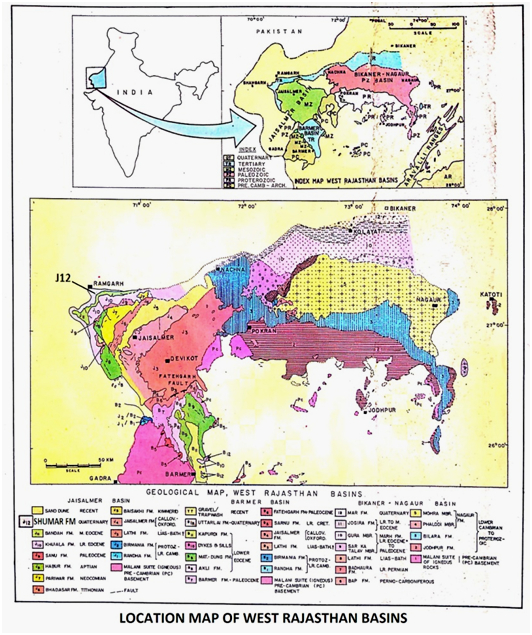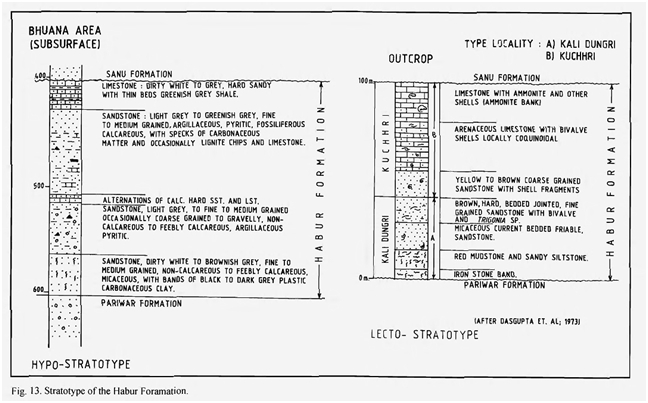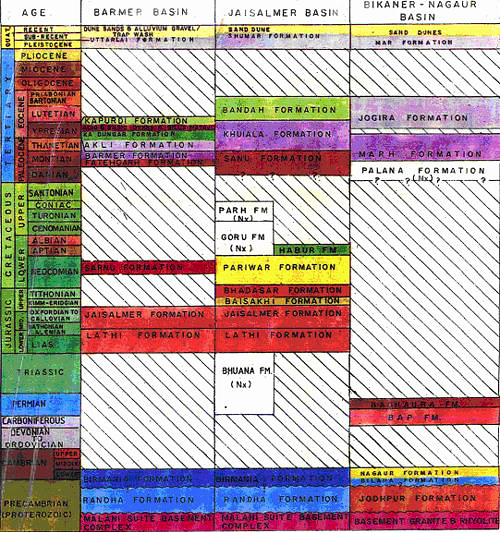Habur Fm
Type Locality and Naming
OUTCROP. Outcrop of Habur village and Kanoi village. [Original Publication: Swaminath, J., Krishnamurthy, J.G., Verma, K.K., and Chandak, G.J., 1959, General geology of Jaisalmer area, Rajasthan, ECAFE Symposium, Mineral Research and Development Series 10: 154-155]. Reference well: Outcrops near Kuchri and Kali Dungri areas. Well Bhuana-1, interval 400-603 m.
Synonyms: Oldham (1886) first described this formation as “Abur beds” and also mentioned its representative outcrops near Kuchri, Habur, Te-Takkar. Carter (1861) and Blanford (1877) also have mentioned about “Kuchri Ammonite Bank”. Swaminath et al., (1959) dropped the word “beds” and described this sequence as “Abur Formation” and the same has continued later (Dasgupta et al., 1973; Mishra et al.,1 993).
Lithology and Thickness
Sandy limestone. This formation comprises mainly alternations of calcareous sandstone and coquina limestone in the lower part, and foraminiferal limestone with shale interbeds in the upper part. Dasgupta et al. (1973) measured its thickness between 90-100 m along traverses in kali Dungri- Serawa, Kuchri and Te-Takkar areas. In subsurface, maximum thickness of the order of 203m has been recorded in the well Bhuana-1.
[Figure 1: Location map of West Rajasthan Basins (after Pandey and Dave, 1998)]
[Figure 2: Stratotype of Habur Fm, Mesozoic Lithostratigraphy of the Jaisalmer Basin, Rajasthan, Journal of the Paleontological Society of India, Vol. 51(2) (after Singh N.P, 2006)]
Relationships and Distribution
Lower contact
The lower boundary between Habur Formation and underlying Pariwar Fm is in the scarp, east of Habur village, is disconformable with the presence of ironstone bands.
Upper contact
The upper boundary marks a major break between Mesozoic and Cenozoic sequences. It unconformably underlies Sanu Fm near Mohammad-ki-Dhani and Kali Dungri. Further in northwest the formation is directly overlain by Khuiala Fm.
GeoJSON
Fossils
The lower part of this formation has yielded Ammonites.
Age
Depositional setting
Shallow inner neritic.
Additional Information


